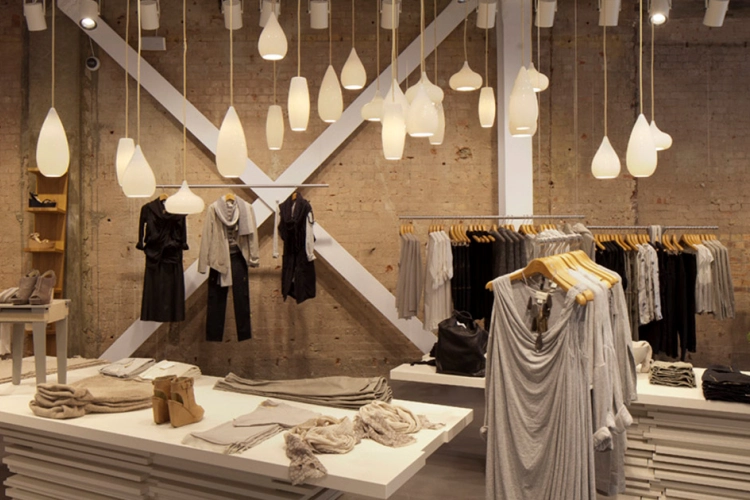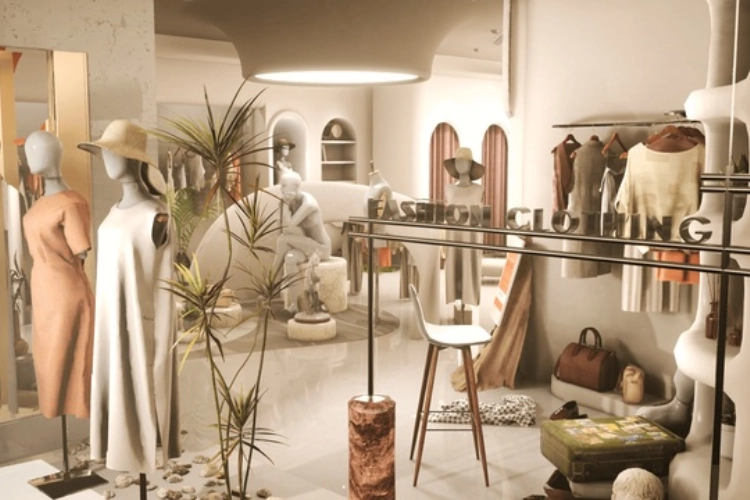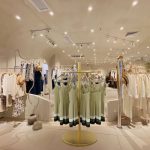Did you know that 90% of retail customers turn right when entering a store? This simple pattern makes your clothing display guide critical for capturing attention in those crucial first moments.
The difference between a compelling display and a forgettable one directly impacts your bottom line. According to retail research, shoppers make 82% of their purchasing decisions in-store, highlighting why visual merchandising deserves your full attention. Effective retail displays don’t just showcase products—they tell your brand story, guide customer flow through your clothing store layout, and ultimately drive sales. Additionally, consistent brand presentation across your retail displays can increase revenue by up to 23%, making mastery of retail presentation techniques essential for success.
Whether you’re launching a new store or revamping an existing space, this step-by-step guide will help you create clothing displaysthat not only catch the eye but also convert browsers into buyers. Let’s transform your retail space into a sales-generating masterpiece!

Plan Your Display Strategy
Before purchasing a single fixture or mannequin, successful clothing retailers first develop a comprehensive display strategy. The foundation of this strategy rests on two critical pillars: understanding who you’re selling to and maximizing the physical space you have available.
Understand your target audience
The effectiveness of your clothing display guide begins with knowing exactly who your customers are. Customer demographics shape every aspect of your visual merchandising decisions. Research shows that different age groups, genders, and income levels respond to distinct visual stimuli. Furthermore, fashion retailers who align their displays with customer psychographics (values, interests, and behaviors) create more meaningful connections.
Consider these essential demographic factors:
- Age: A bright, colorful installation with multiple screens might appeal to younger shoppers but deter those in the 50+ demographic
- Income level: Your fixtures and presentation should match price expectations—luxury customers recognize subtle display cues
- Location: People living in different geographical areas have varying fashion preferences and needs
Beyond basic demographics, explore customer shopping behaviors. Are they impulsive buyers or methodical researchers? Do they shop alone or with friends? These insights directly influence how you should arrange your retail displays for maximum impact.
Audit your store layout and space
Most shoppers instinctively turn right when entering a store and move in a counterclockwise pattern before exiting. Consequently, the right side of your entrance becomes your “power wall”—prime real estate for showcasing high-demand products or premium promotions. This area sets the tone for your entire shopping experience.
When conducting a store layout audit, evaluate:
- Customer flow patterns throughout your space
- Areas receiving high versus low traffic
- Potential bottlenecks, especially at the entrance
- Accessibility and comfort (sufficient aisle width for shoppers to pass)
- Visual merchandising effectiveness and brand compliance
“Square footage doesn’t always mean more sales,” according to research by Universitas Mercu Buana, which found that smaller, well-organized stores often outperform larger ones with poor layouts. The optimal layout for your clothing store depends primarily on your spatial requirements, product types, and target audience.
Consider organizing your store into distinct zones for different product categories to streamline the shopping experience. This creates a logical flow and encourages cross-selling opportunities. Additionally, implementing modular fixtures offers flexibility to adapt to seasonal changes or evolving consumer trends.
Regular store audits provide invaluable insights into your visual merchandising effectiveness. They help identify inconsistencies in displays, evaluate product placement, and verify that your store presents the best possible version of your brand.
Choose the Right Display Elements
The visual elements you select for your clothing displays serve as the physical embodiment of your brand’s personality. Research shows that well-chosen display fixtures can significantly boost sales, with properly highlighted merchandise selling up to three times faster than items that blend into the background.

Select fixtures that match your brand
Your display fixtures should complement—never overpower—your clothing. OPTO’s retail design experts emphasize that “it’s time to move on from clunky, outdated retail apparel fixtures that distract from your clothing”. Instead, choose modular systems that showcase your products while reinforcing your brand identity.
When selecting fixtures, consider:
- Material quality and durability for long-term use
- Flexibility to adapt to seasonal changes
- Esthetic alignment with your overall store theme
Modular display systems offer unparalleled versatility, allowing you to effortlessly adapt to evolving merchandising needs throughout the year. Moreover, they provide the flexibility to experiment with different layouts while maintaining visual consistency.
Use mannequins and props effectively
Mannequins aren’t merely clothing holders—they’re “storytelling vehicles” that dramatically influence sales. Items displayed on mannequins consistently achieve higher sell-through rates because they help customers visualize products on themselves.
Today’s retail landscape demands mannequin diversity. Research indicates customers “gravitate to where they see themselves represented”. Major retailers like Target have invested in size-inclusive mannequins (sizes 4, 10, and 16), while brands like Athleta showcase forms in varied poses with different hairstyles.
Position your mannequins strategically in high-traffic areas, particularly at store entrances where they can immediately communicate your brand story. Although using props alongside mannequins creates more engaging visual narratives, remember that simplicity often prevails—too many items can overwhelm potential customers.
Incorporate lighting to highlight key items
Proper lighting does more than illuminate—it sells. Retail experts note that “used correctly, lighting can help you sell more” by creating ambiance that attracts attention and enhances the shopping experience.
Implement a mix of lighting types:
- Accent lighting to highlight specific displays or featured items
- Bright, natural-mimicking light for entrances and task areas
- Blue-toned lighting to emphasize sparkly accessories or evening wear
Strategic lighting placement guides customer attention through your store while simultaneously showing garment colors accurately. In essence, your lighting choices communicate which pieces deserve special attention in your clothing display guide.

Build and Arrange Your Displays
The arrangement of your merchandise transforms ordinary racks into compelling stories. Once you’ve selected the right fixtures and elements, assembling your displays brings your clothing display guide to life through strategic product organization.
Group products by theme or collection
Grouping similar products creates a natural shopping rhythm that saves customers time. Unlike scattered displays, themed collections provide additional purchase motivation as shoppers can easily visualize complete looks. The approach resembles creating categories while simultaneously developing “groupings” within them—arranging items by color, price, size, or type.
Themed collections work effectively because they tell a cohesive story. When OPTO’s retail experts evaluated successful brands, they found that displays communicating a clear narrative increased customer engagement by highlighting complementary pieces. For instance, positioning dips beside chips or peanut butter near jams gives shoppers logical reasons to buy multiple items.
Use focal points to guide attention
Focal points act as visual magnets, deliberately designed to capture customer attention. Retail research demonstrates that strategic focal points guide customers through your store while influencing purchasing behavior. The most effective focal points typically appear in high-visibility areas:
- Store entrances and windows
- End of shopping paths
- Frequently traveled zones
Spotlights and directional lighting naturally draw eyes toward featured merchandise. For maximum impact, create multi-level displays that encourage customers to look up, maximizing retail space while guiding visual flow through your products.
Apply color blocking for visual impact
Color stands among the most powerful tools in visual merchandising—it attracts attention, conveys meaning, and influences buying behavior. Color blocking involves juxtaposing contrasting colors to create eye-catching displays that make specific products stand out.
Effective color blocking strategies include:
- Using contrasting shades like black and white
- Creating monochromatic displays with varying shades of one color
- Organizing products by color to facilitate easy shopping
Keep displays clean and uncluttered
White space serves a crucial purpose in retail—it provides customers room to breathe while highlighting key products. Uncluttered displays reduce visual confusion and create a sense of order that customers prefer. Research shows organized retail environments significantly improve shopping experiences.
Maintaining clean displays requires regular attention. Schedule monthly revisions to intrigue customers with fresh arrangements.
Test, Rotate, and Improve
First and foremost, creating perfect clothing displays is an ongoing process. Even the most carefully crafted displays require continuous evaluation and refinement based on real-world performance.
Track customer interaction with displays
Successful retailers constantly analyze how shoppers engage with their clothing displays. Retail analytics tools provide valuable insights by measuring customer dwell times and interactions with specific display areas. This data reveals which display elements capture attention and drive sales. Tracking key performance indicators like Customer Engagement Score, interaction rates, and dwell time helps quantify display effectiveness.
Smart retailers implement systems to monitor:
- Traffic patterns throughout different store sections
- Time spent examining specific displays
- Conversion rates from browsing to purchasing
These metrics help identify high-performing elements that can be replicated across other locations. Subsequently, you can optimize product placement for maximum visibility and accessibility.
Rotate displays seasonally or monthly
Display fatigue is real—even regular customers stop noticing unchanged displays over time. Retail experts suggest updating product displays monthly to maintain customer interest. This regular rotation keeps your store fresh and ensures returning shoppers discover something new with each visit.
Consider these rotation strategies:
- Move existing displays to different store locations two weeks after setup
- Create seasonal themes aligned with holidays or events
- Implement monthly merchandising themes that highlight different collections
Indeed, a seasonal program allows you to refresh your space and delight customers with each visit. This approach creates shopping environments that captivate customers through immersive experiences, ultimately leading to increased sales.
Gather feedback and make adjustments
Retail success requires listening to your customers. Implement mechanisms for collecting shopper opinions about your displays through surveys, QR codes, or interactive kiosks. Digital comment boxes can gather real-time feedback, enabling swift adjustments to your visual merchandising.
Thereafter, integrate this customer feedback into your display strategy. Post-purchase emails requesting product reviews can generate valuable insights—research shows approximately 60% of reviews come from these follow-ups. Essentially, this continuous feedback loop helps you refine your clothing display guide over time, ensuring your visual merchandising remains effective and responsive to customer preferences.
Conclusion
Creating perfect clothing displays requires thoughtful strategy and consistent execution. Effective visual merchandising starts with understanding your target audience, thereby ensuring displays resonate with shoppers’ preferences and behaviors. Most importantly, your store layout serves as the foundation upon which all display decisions rest.
The right display elements act as silent salespeople for your brand. Fixtures that complement your merchandise, strategically positioned mannequins, and purposeful lighting work together to highlight your clothing collections. These elements, when selected carefully, can increase product visibility and drive sales significantly.





